Menu Links
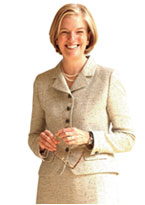
This past year Pearson passed a number of important milestones, but there are three that may interest you most as shareholders:
- We produced record results - the highest profits, earnings per share, cash flow and dividends in Pearson's 162-year history.
- The changes we've been making to the company paid off not only in those strong financial results, but also in the fact that the returns we made were higher than the cost of the capital you've invested in us. In today's business parlance, that's called 'creating value', and we intend to do a lot more of it.
- It became clearer than ever that the strategy for each one of our businesses is a winner. A resurgent Financial Times showed that its international outlook and online capabilities were made-to-measure for this era of globalisation and technological transformation. A buoyant Penguin defied a difficult market and proved that there are always buyers for the world's best books. And a flourishing Pearson Education, through its scale and innovation, helped students of all ages get more out of their formal learning while it was posting its own record profits.
But, important as those achievements are, none of them means that we've achieved our goals or arrived at our destination.We nod to the milestones as we pass them, but we move on at an even faster pace, continuing to invest and to change. It's crucial that we do that, because we're living through a genuine revolution at the heart of what Pearson does: educating, informing and entertaining; provoking the intellect and helping people get on in their lives.
We believe our strategy puts us in a good place to be on the barricades in that revolution - not a victim of it. About ten years ago, we began to focus on 'education' in the broadest sense of the word and to invest to make each one of our businesses a world leader. Our definition of 'leadership' was partly about scale, but more fundamentally about shaping markets with the quality of our content, innovation, technology and our international reach and point of view.We're always revisiting and refining that strategy, but these 2006 results and our sustained momentum give us confidence that the approach is working.
For details of our 2006 results, visit www.pearson.com
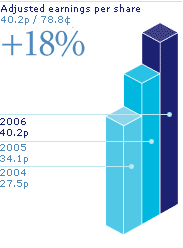

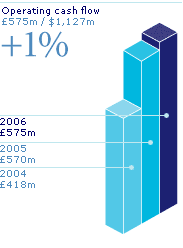
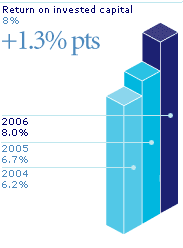
Who wins an education revolution?
The future of history.
The teacher is in control.
Listen more in class.
iPods and other MP3 players started a revolution in the way we listen to music... >
In 2006, when the state of California invited publishers to submit proposals for new textbooks in history and social studies, we tried something new. We provided a complete digital curriculum, allowing teachers to create lessons from a rich mix of videos, class exercises, tests and digital books. This innovative approach swept the state, taking a market share of more then 40% and the programme is in use by half of California's elementary students. We're now extending this new digital model to new subjects and new states.
To learn more about our world-leading education business, visit www.pearsoned.com
For some years now, we've planned for the day when technology would transform education, just as it has transformed the worlds of science, medicine, business and finance. We expected that a computer, linked to a network, might be able to solve a problem that has faced every generation of teachers: how can we teach each child while keeping order in a class of many? Technology held out the promise of teaching that could adapt to the learning pace and needs of each child.
Critical information about student attendance and performance is moving from the teacher's register to powerful software tools. In America, 30,000 schools serving 25 million students are using Pearson's student information systems. These give teachers detailed data about the progress of each child - which the teacher can use to assign an individual course of learning. And they save teachers time, automating the complex reporting systems that are required by states and the federal government.
That was an alluring dream - both as an educational proposition and as a business opportunity - and we began to invest in it about ten years ago. We became the world's leading publisher of educational materials, and then a few years later we added America's leading educational testing and technology company. Those three parts - content, assessment, technology - were the basic building blocks that we needed to personalise learning; to put in place a way to help education that's already almost universally available finally become universally effective.
iPods and other MP3 players started a revolution in the way we listen to music. Now we are using them to help students prepare for their exams. Wherever students are - whatever they are doing - they can study by listening. Our downloadable audio study guides are aligned to their class text and are available by chapter or for the whole text. Students get just-in-time practice tests, reviews, and quick drills to sharpen their knowledge right before the test.
Like most revolutions, it took a while to foment. But today, you can see the signs that it's well under way:
- Governments are putting personalised education at the centre of their plans for improving their students' performance. While the US government calls its education agenda 'No Child Left Behind', its UK counterpart talks of 'personalised learning'; but they mean the same thing.
- Students and their teachers - especially the new generation that grew up with technology - are embracing it as a way to enliven learning and to help schools, teachers and students all be more productive.
- The competitive landscape is changing fast. In the past six months, four of the world's six largest education companies have been put up for sale, citing the need to invest in scale and technology to go to the next stage.
Pearson Education 2006 highlights
- Sales up 4% to £2.9bn
- Operating profit up 12% to a record £405m
- Market share gains in US School and Higher Education publishing
- $1bn of sales in School and Professional testing
- Approximately $1.1bn of technology revenues - more than 20% of education sales
We've already made that investment; it helped us pass those milestones. Our School business, which grew sales by 16% in 2005, grew another 6% last year. While the US publishing market and our competitors declined, we grew in publishing, testing and technology, and benefited from a pretty unique breadth of content and services.
At the same time, our Higher Education business grew 4%, propelled by its pioneering online services for college students that have proven over time they really help learning. In the past eight years, the US Higher Education industry has grown at an average rate of 4%, while our business has grown at 7%.
And last year our Professional education business grew again too, buoyed by the newer businesses we've been building to test and certify professionals, from nurses to potential MBA students to securities dealers. That business has doubled its sales in the past two years alone.
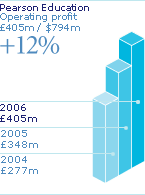
In fact, all parts of our education business did well in 2006, helped by a welcoming attitude toward change and investment. Combined, they produced record profits of £405m, an increase of 12% on 2005. In fact, over the decade we've been building this business, its sales have increased five-fold and its profits six-fold.
And it will continue to grow as the revolution grows. It will propel Pearson forward and help us achieve our goals, both for the company and for the world that surrounds us. In a competitive global economy, all nations share the need to have education and skills, and to sharpen them constantly.
Around the world, governments, educational institutions and individuals are investing - sometimes at great sacrifice - in education. It's no wonder they have only one measure of return on that investment - the success of the student. Our business, with its mix of learning content, technology and assessment, is built to help achieve that return. That's the goal of the revolution in education that, so far, we're winning. But we're only sure to sustain our lead if we remember that the real winners of a revolution in education will be the student and society.
Who killed the newspaper?
The bucks start here.
For the best analysis of global trade, companies and finance, business people and investors turn to the Financial Times. Over the past ten years, we have transformed it from a UK business newspaper into a truly international media franchise. Today, two-thirds of its circulation comes from outside the UK and around half of its advertising is booked to run in all four regional editions of the newspaper worldwide. The FT has a unique platform to build its position as the gold standard for international business news in the era of globalisation. In 2006, with circulation increasing and international advertising growing strongly, the newspaper posted an £11m profit - up from £2m in 2005.
All the time we've been changing the shape of Pearson, we've placed great emphasis on its culture. We believe that what a company stands for and how it behaves is critical to its success. One of the things we prize most highly is editorial independence. Pearson has a long history of honouring and defending the rights of editors to decide what books Penguin should publish; what materials are worthy of inclusion in a school book; what the FT's position should be on issues of the day.
For the FT's global news and analysis
throughout the day, visit www.ft.com![]()
So in one way we were proud not too long ago when The Economist (of which Pearson owns 50%) dedicated its cover to asking: Who killed the newspaper? In that issue it analysed, with all its accustomed probity, wit and style, the issues facing the newspaper industry: a proliferation of news sources; information freely available on the internet; young consumers turning to other forms of media.
Yet The Economist bashfully omitted telling its own story in that article. It's a newspaper (a weekly, and probably not called a newspaper by anyone but itself anymore) that has swum against the tide. Its circulation has doubled in the past 12 years to reach 1.2m in 2006; and its relevance as a commentator has never been greater or more in demand around the world.
Tool of the trade.
FT.com, the newspaper's online partner, has transformed the FT from a once-a-day morning read into a through-the-day business tool. Today it has 90,000 subscribers and in 2006 online advertising grew by more than 30%.
For another example, take the Financial Times. It's a newspaper that we've transformed from a domestic business daily into an international service, selling more than two-thirds of its pink copies outside the UK and publishing through the day online. In fact, it's been a digital newspaper pioneer, with a highly popular and helpfully profitable online presence in FT.com and a new way of working that allows journalists, readers and advertisers to switch seamlessly from print to digital and back again.
Those advantages weren't developed enough to prevent the FT from suffering, along with the rest of the industry, from a savage advertising slump between 2000 and 2004. But in the past two years they've gotten more powerful, and the paper has emerged from those dark times faster and fitter than many of its rivals, contributing once again in a meaningful way to Pearson's profits.
So while parts of the newspaper industry may be dying - or at least feeling a little grey - our global newspaper is actually in the pink thanks to these advantages:
- First of all, it's a well-known and special brand, built on a century-long record of independence and authority. It stands for insight, comment and analysis in an era when reporting what happened yesterday has become a commodity. It provides services that are hard for the search engines and content aggregators of the digital world to replicate: judgement about what in the world deserves attention; and serendipity - that chance discovery of something that provokes wonder.
- Most of all, its success is based on the fact that it is truly global, in its worldview as much as in its influence and reach. (While demand for newspapers is slowly declining in developed markets, it is actually on the rise in developing countries around the world, including China and India.)
FT Group 2006 highlights
- Sales up 6% to £698m
- Operating profit up 18% to £121m
- Financial Times increases profit to £11m (from £2m in 2005)
- Circulation growing at the FT, Les Echos, FT Deutschland and The Economist
- IDC reports record profits of £89m, up 9%
The Financial Times attracts an elite audience of influential and affluent leaders in business, financial and political life - and that audience resides at addresses all around the world. Because of that, among a constellation of media channels with fragmented groups of followers, it still offers advertisers a highly targeted and effective medium for connecting with the people who run the world.
Today about half of the FT's advertising sales come from global packages - pages bought simultaneously in every edition around the globe.
But the FT hasnt stopped at refining and reinvigorating its global newspaper. Its added to that a number of new editorial-led services - most recently through the acquisition of Mergermarket, an online service that helps finance and other interested professionals predict and track mergers and acquisitions and other market events.

All those special advantages helped the FT Group increase its profits by 18% to 121m last year. Within that was steady growth from IDC, our ever-dependable financial data company. And FT Publishing, our group of business newspapers, magazines and online services, saw profits jump by more than half as cost reductions paid off and as advertising revenues returned.
With those advantages, the FT Group's good progress can continue. There's a new team there, and their plans include some simple approaches to sustain growth: increasing revenues from readers (who are more constant than advertisers); enhancing online services; continuing to grow around the world, and to be global; and integrating the financial publishing businesses ever more closely.
With those changes, we expect FT Publishing to increase its profitability once again this year. Our goal is to move its margins into double digits (from 8.7% in 2006), and to make those margins sustainable through the inevitable swings of the advertising cycle. Our goal is not to spend time looking for a murderer, because there's no corpse this newspaper is alive and well.
Who has time to read?
You can win them all.
Around the world, Penguin authors won unprecedented critical acclaim in 2006... >
Around the world, Penguin authors won unprecedented critical acclaim in 2006. They swooped the Pulitzer Prize for fiction (Geraldine Brooks for March); a National Book Critics Circle Award (Francine du Plessix Gray for THEM: A Memoir of Parents); two Orange Prizes (Zadie Smith for On Beauty and Naomi Alderman for Disobedience); two Whitbread Prizes (Ali Smith for The Accidental and Hilary Spurling for Matisse: the Master) and the Man Booker Prize for Fiction (Kiran Desai for The Inheritance of Loss). Publishing successes like these helped Penguin to a record year for bestsellers with 139 books on the New York Times bestseller list and 59 titles in the BookScan Top Ten bestseller list in the UK.
The book publishing business might look like the one corner of the media world that's been left relatively untouched by the digital revolution. While downloads and MP3 players have changed the music industry forever, the popular paperback invented by Penguin's founder Allen Lane back in the 1930s appears still to be a convenient and enduring format for a certain kind of entertainment.
Designer jackets.
For six decades, the Penguin Classics have represented the world's best literature, kept alive by great publishing and design flair. To celebrate their 60th birthday, Penguin invited five of the world's most renowned designers to put their mark on their favourite book. The designer classics - produced in a limited edition of 1,000 books each and sold at £100 - sold out in a matter of weeks.
For more information about Penguin,
its books, its authors and its online
innovations, visit www.penguin.com![]()
But that's just part of the story. Its true that the digital distribution of books and the digital distribution of content from books have been very slow to develop. Electronic books (books down-loaded onto some kind of device, like your PC or a PDA) represent a tiny fraction of the industry's sales so far. Although a new generation of e-book reading devices could yet change everything, it looks for the moment as though books retain more consumer appeal than downloadable text.
There are, however, plenty of behind-the-scenes ways that digital technology is remaking the book business out of all recognition less obvious, but no less significant ways. In fact, it changes every area of book publishing: how we create content, how we store it, sell it, licence it, manufacture it and protect it.
Penguin Group 2006 highlights
- Sales up 3% to £848m
- Operating profit up 22% to £66m
- Record bestseller performance: 139 New York Times bestsellers in the US and 59 BookScan Top Ten bestsellers in the UK
- Rapid growth in India, China and South Africa
- Successful innovation in digital marketing and new product models
Communication with book readers, centred on a particular author or title or publishing genre, has been changed, too. Its become more direct, more immediate and more personal. The audio book is making a comeback, made relevant again to a mass audience through iPods and other MP3 players. And the giant search engines do offer the promise of new ways for readers to discover authors and books - so long as they recognise the ownership rights of the content creators.
This past year, Penguin continued to imagine this future and to invest in and participate in the digital world. It saw rapid growth of around 30% in online sales, through specialist retailers like Amazon and through its own websites. It sold travel guides in small chunks and some novels on subscription, chapter-by-chapter. It used the internet to get communities talking about books, and it even convened an online audience of some 60,000 to collaborate on a novel.
But while all that digital innovation was going on, Penguin also continued to excel at what it has done best for the past 70 years. It simply published the best books in the world, logging a record number of bestsellers and winning a remarkable string of awards. Behind that it became more efficient, making higher margins, using less working capital and delivering a seamless supply chain performance.
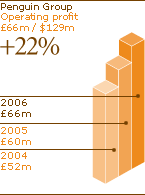
Those efforts meant that, as Penguin gained share in the US and the UK last year, margins moved ahead and profits rose 22%, to 66m.
We've made some important changes at Penguin over the past few years. The consumer publishing market grows at a modest but steady rate and publishers bear the risks of paying authors upfront for their works and then taking back books that retailers can't sell. So our aim is to produce rising margins, profits and cash, while investing in publishing that spreads our risk across a wider portfolio of authors and genres and makes the very most of our long, deep backlist.
That strategy, coupled with Penguin's publishing excellence and its readiness for the digital world, means that it should continue to grow profits steadily over the next few years, taking advantage of the fact that, in the US alone, more than 4,000 books are sold every minute of every day. Someone out there loves reading.
Who are we?
Food for thought.
All Pearson's businesses depend on children and adults wanting to read - for business, for education or for pleasure. So our charitable activities centre on projects that inspire the joy of reading. In the US, we helped our partner Jumpstart set a new record for the world's biggest ever shared reading event. On 24 August 2006, more than 150,000 children and adults read the classic Penguin book, The Little Engine That Could. And in the UK, we launched a programme to provide a free book to 250,000 five-year-olds as they start school - this year, Lynley Dodd's Hairy Maclary's Bone (on which she and her New Zealand publisher generously waived all royalties). In partnership with Booktrust and the UK government, this year we will roll the programme out nationwide.
There's something special about each one of Pearson's businesses. Our customers put their trust in us when they teach from our school or college programs, act on our test results, rely on information, analysis and the intellectual stimulation of our newspapers and books. We know that helping a five-year-old learn to read or helping a business person understand a global context has to be as enriching for those customers as it is for us and for our shareholders, because our strong financial performance will only come if it is the by-product of helping those customers get on in their lives.
We speak everyone's language.
Governments in Africa have set a goal of providing primary education for all children - a massive commitment for a continent which currently has approximately 50 million out-of-school children. Responding to the need to raise standards of literacy and numeracy across Africa, Pearson is developing the first world-class programme for primary school teaching across the continent. Pooling resources from our companies in 15 African countries, we have used expert authors from Africa and all around the world to develop a programme with a strong emphasis on teacher training and assessment. The programme will be rolled out from 2007, initially in South Africa and Nigeria, and will then be adapted for many other markets.
For all 29,000 people who work at Pearson, that combination of shareholder, customer and social interests makes it a special privilege and a special responsibility to come to work every day. It gives us the steam to go the second and third mile.
We're very proud of all we achieved in 2006. It was a year when we made as much progress on our mission of educating, informing and entertaining as we did on our financial goals; and a year when we began to realize the competitive advantages of scale and strategy we have.
But we're now heading toward our goals for 2007 as if we were the underdog. That's the kind of spirit and imagination we need if we want to continue to lead a revolution in our markets and at the same time make exciting returns for all who count on us. And in the lead is where we intend to be.

Marjorie Scardino, Chief executive
